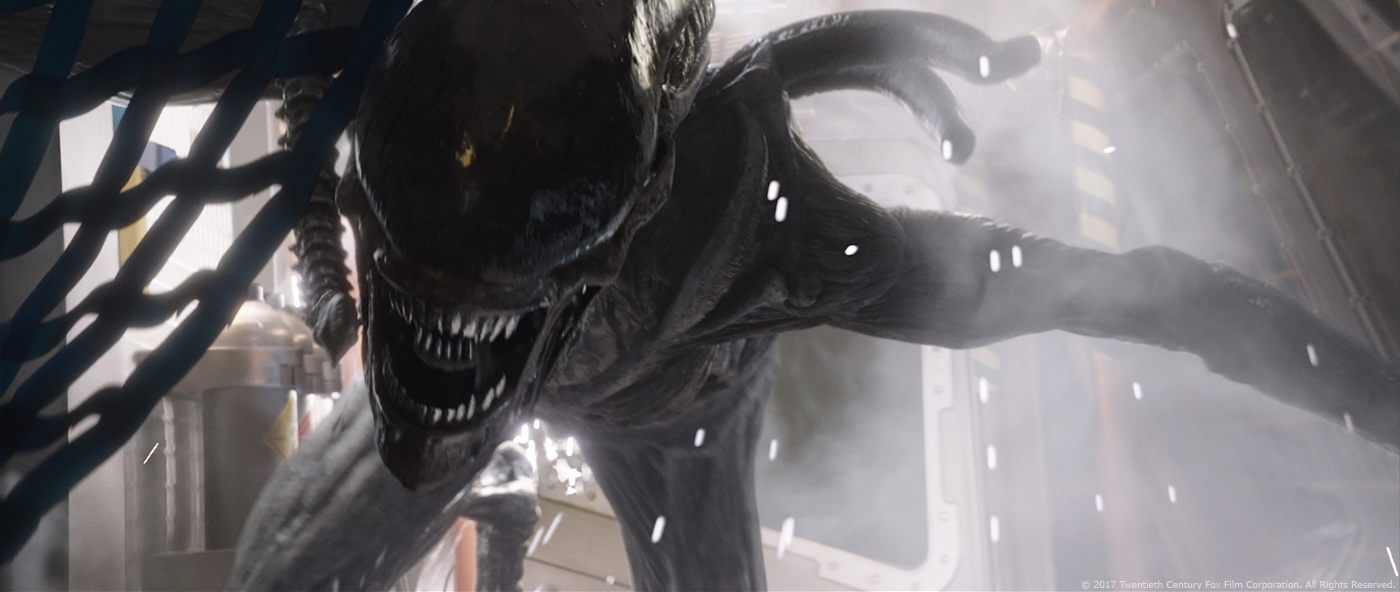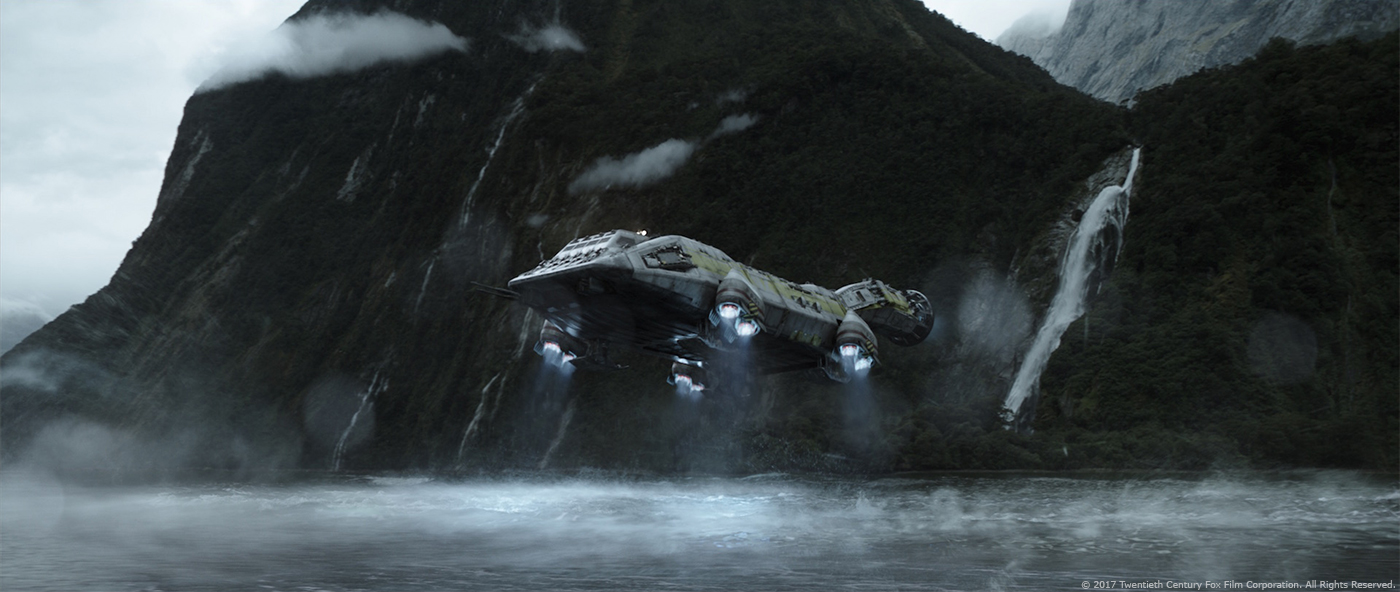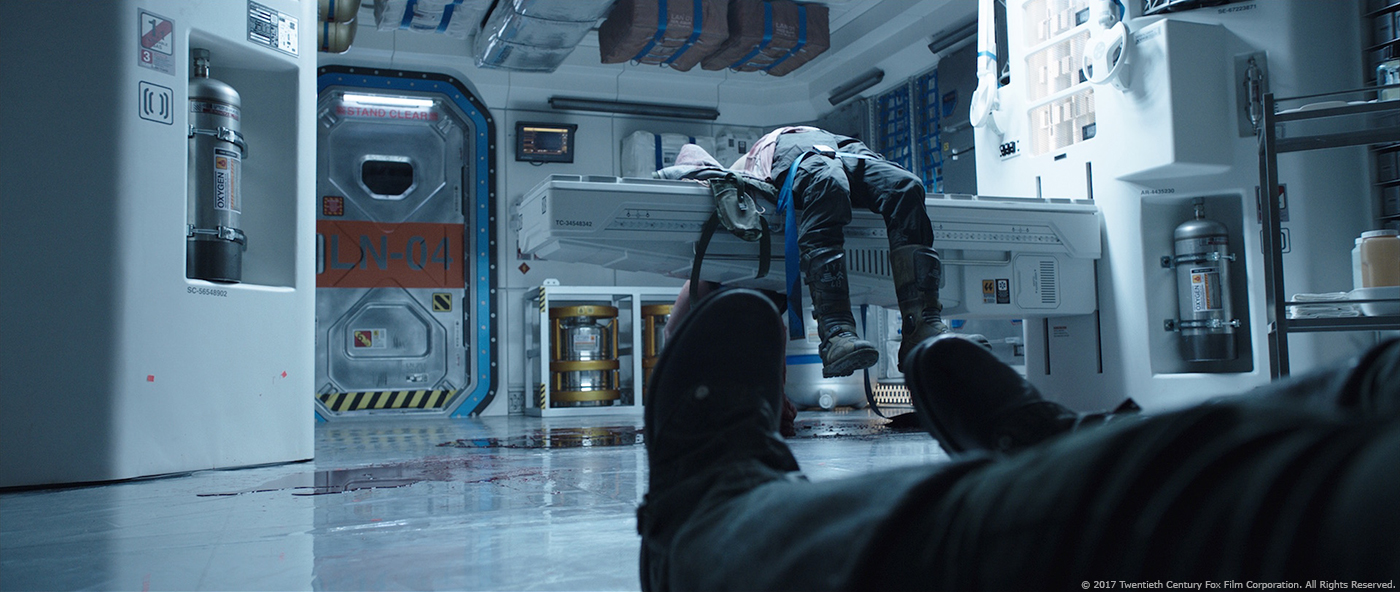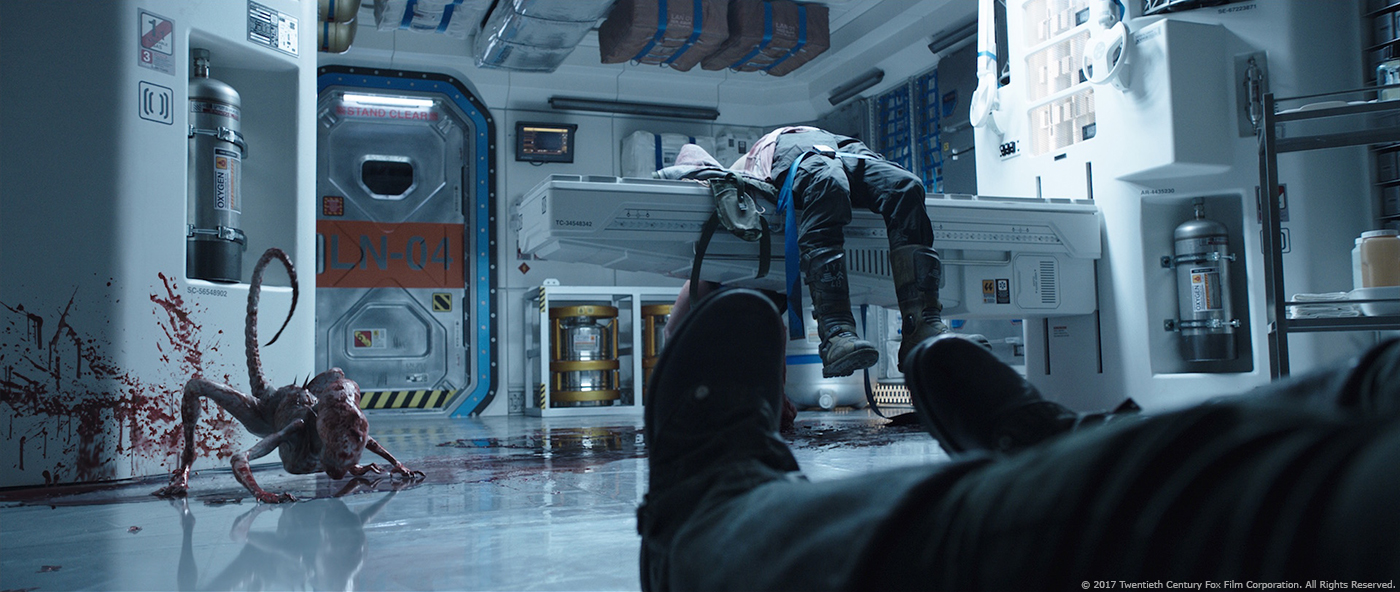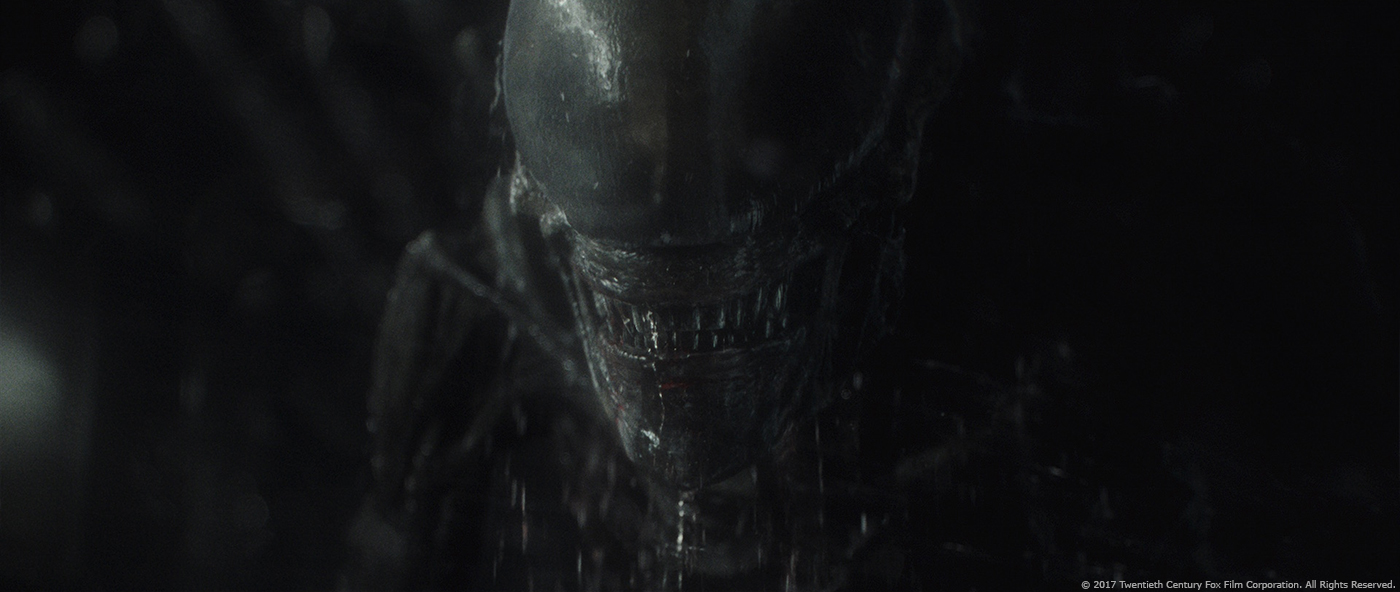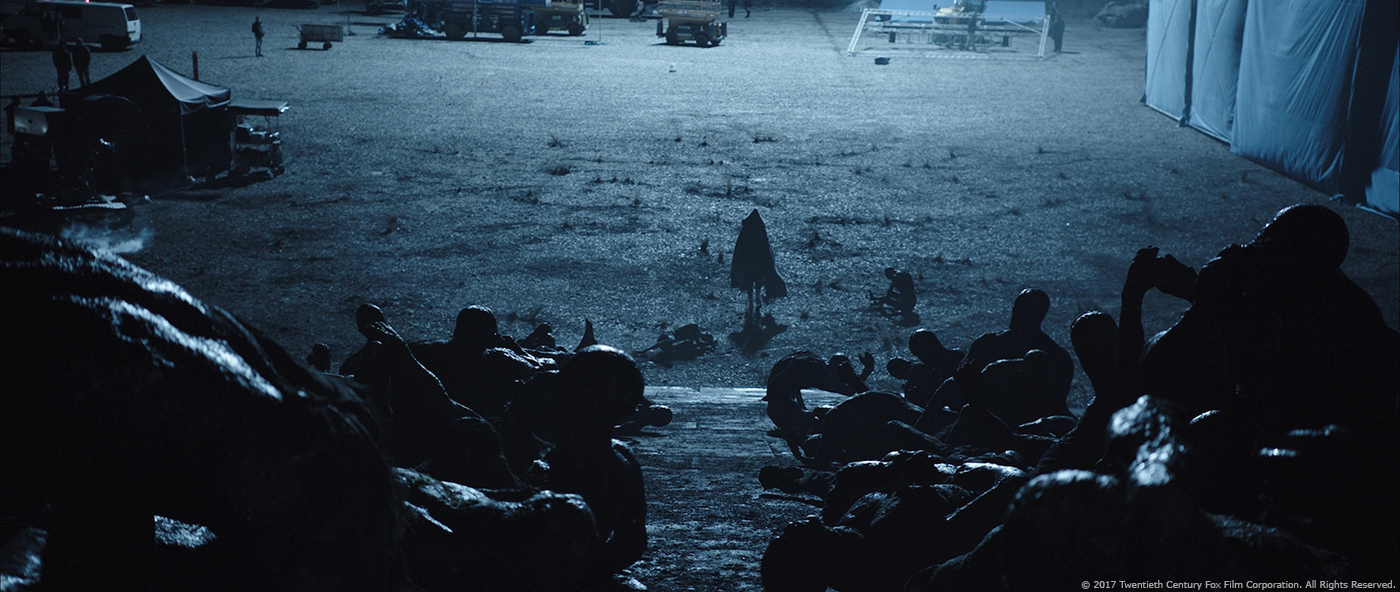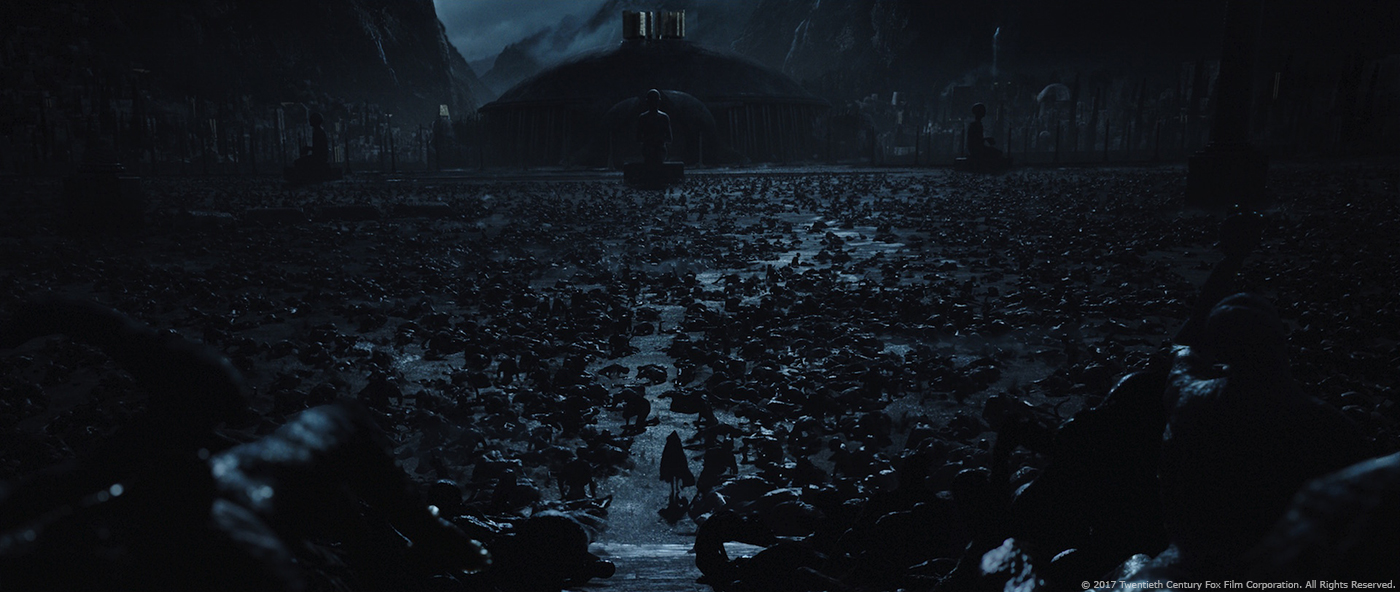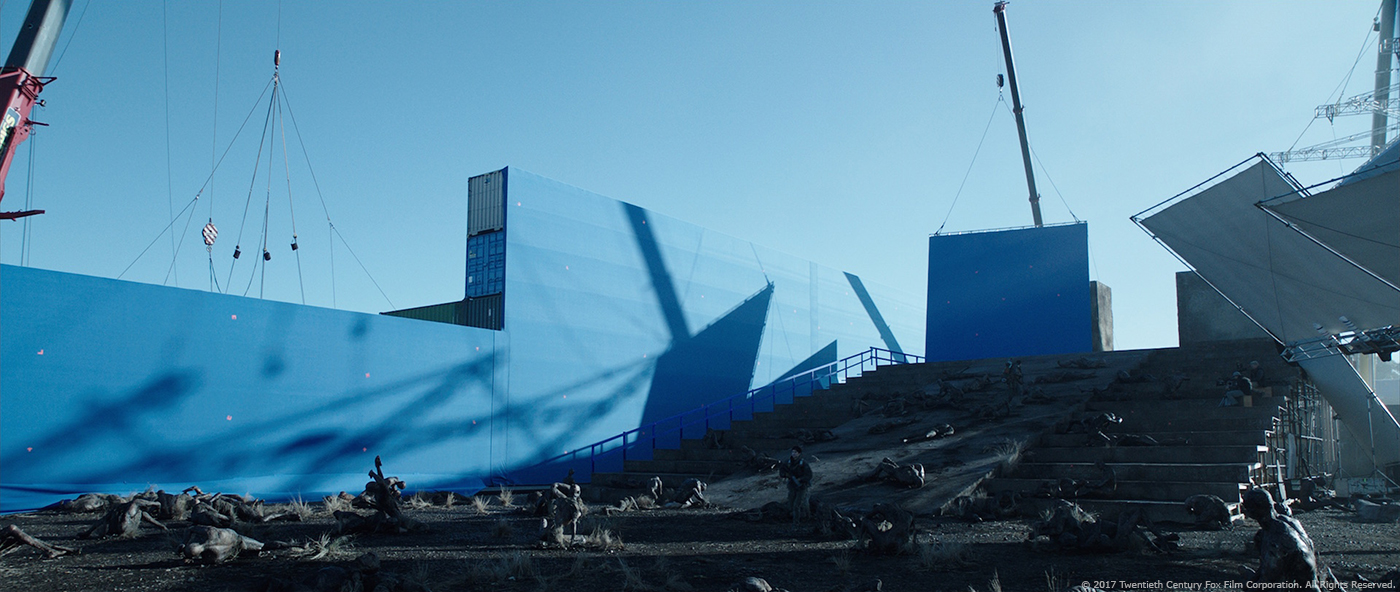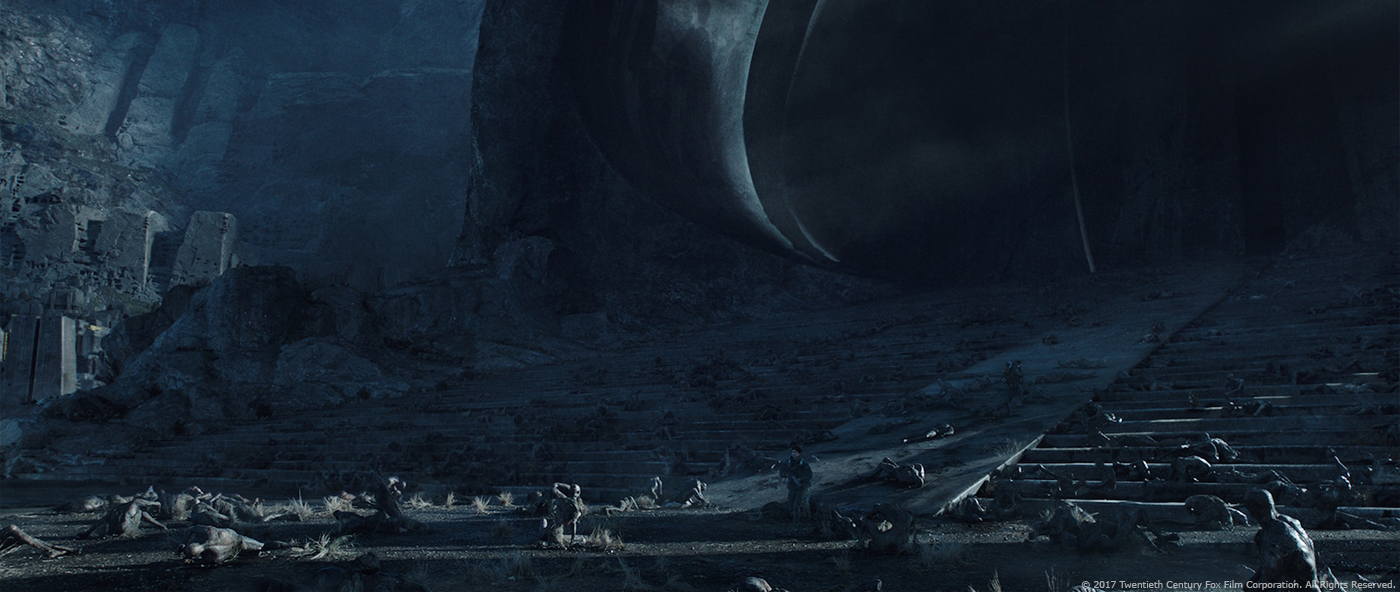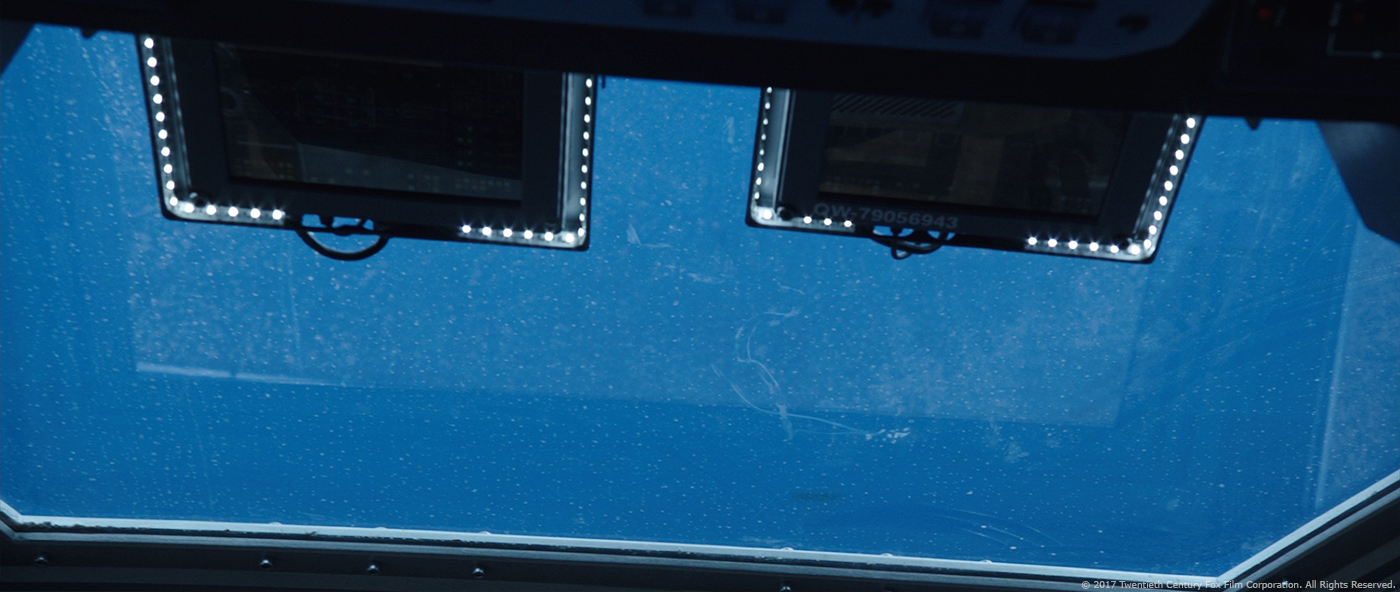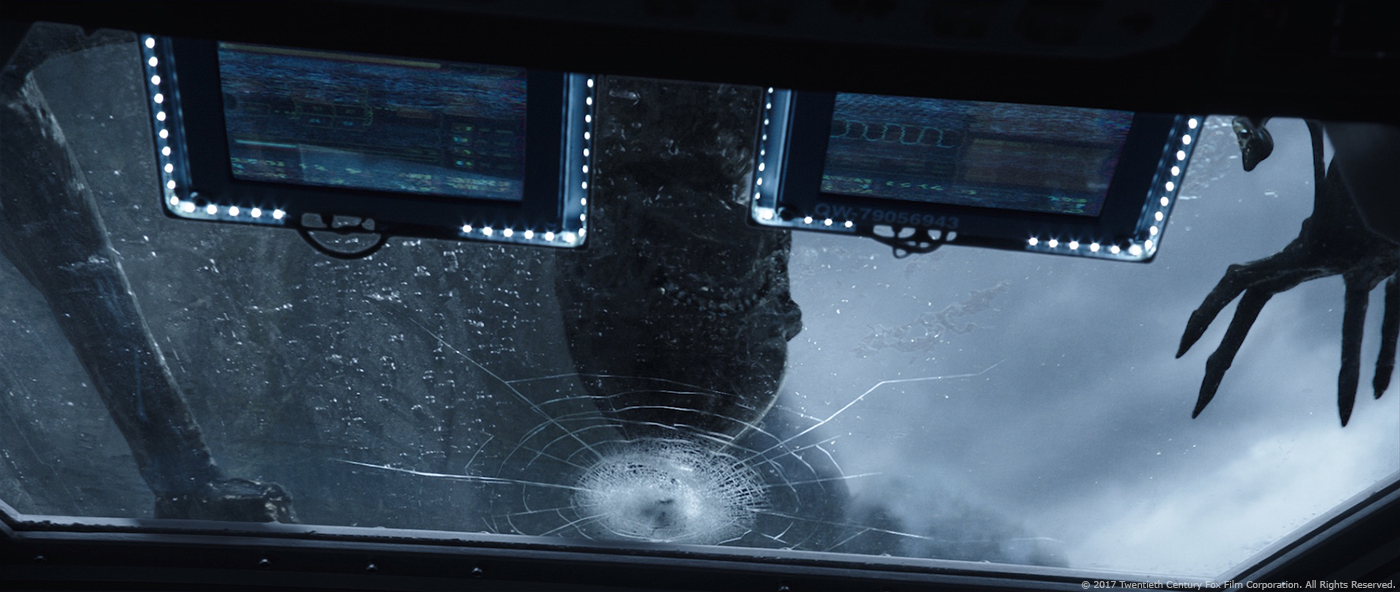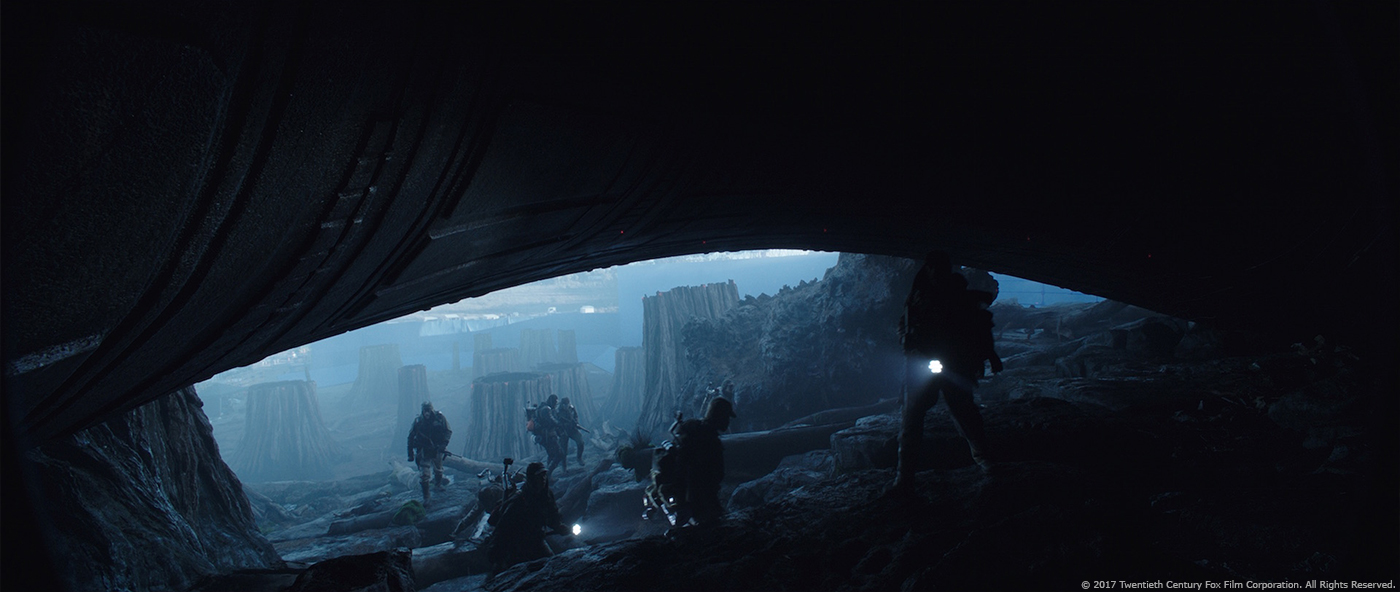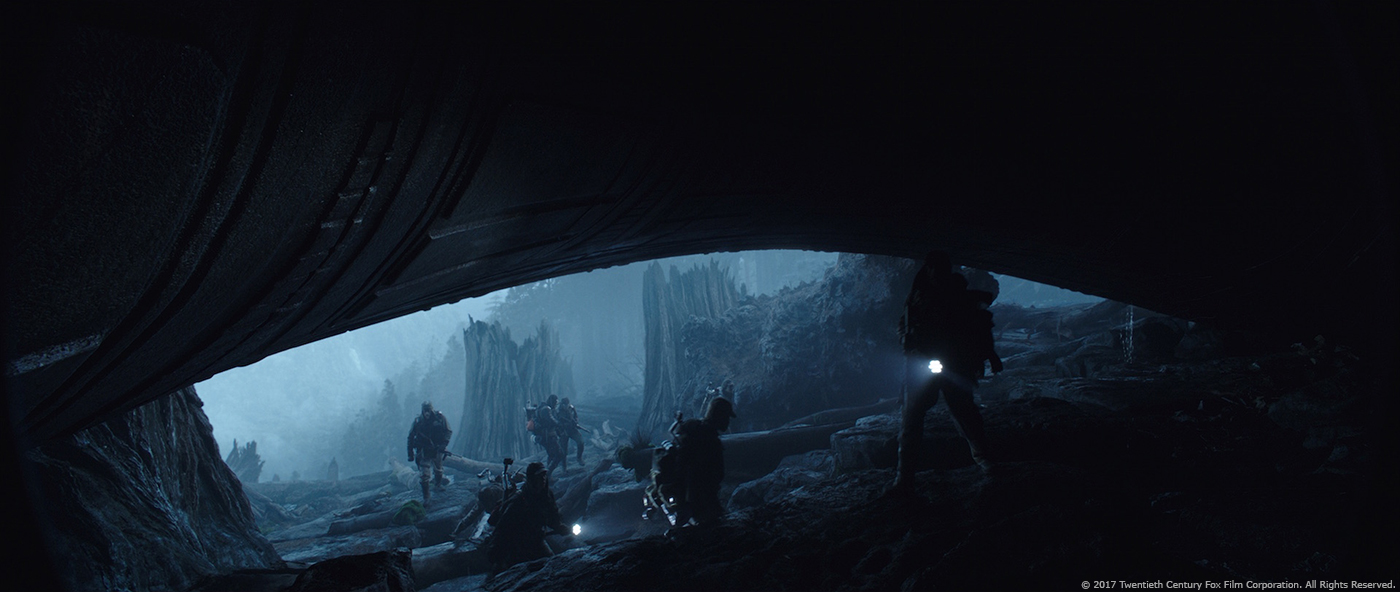Few months ago, Ferran Domenech explained to us in detail about the MPC‘s work on A MONSTER CALLS. He also took care of the visual effects of FANTASTIC BEASTS AND WHERE TO FIND THEM. Today, he talks to us about his work on ALIEN: COVENANT.
How was the collaboration with director Ridley Scott and VFX Supervisor Charley Henley?
I’ve known Charley for many years. He is the best collaborator you could find who is extremely talented and has a great eye for detail. I always look fondly at the work we did on PROMETHEUS and I was thrilled to join him once more on ALIEN: COVENANT. Ridley is a joy to work with from a visual effects point of view as he is a director with a crystal clear vision. His mind’s eye is shaped like a viewfinder, constantly searching for new shots, and then drawing what he sees. The fact that he consistently creates these sketches that the crew likes to call ‘Ridleygrams’, is amazing. When reviewing or briefing work, he draws everything in play, anything from black and white doodles to full shaded colour illustrations. A ‘Ridleygram’ is worth a thousand words, so the crew can concentrate a higher percentage of available time to the details of every frame. I think this is one of the reasons his films always look so beautiful, because with laser focused direction you can get even better work out of the crew, and the artists respond and thrive on this.
What were their approaches and expectations about the visual effects?
When joining a Ridley Scott production, the expectation of high fidelity VFX is a given. I had the experience from PROMETHEUS so I knew what would be required. We knew about striking landscapes and big action set pieces; except this time, at a larger scale. The biggest unknown was the work involved to develop the Xenomorph’s and Neomorph from concept art into fully realised creatures.
The approach from start was to do thorough research. Ridley wanted to reference nature every step of the way. Textures, material properties and animation, all of it would be derived from references to ground the creatures in reality. So, we built a library of insects, animals and performance clips which included very specific references Ridley had in mind.
What was your feeling to be part of the Alien universe?
To be invited to play on the universe Ridley Scott created back in 1979 is amazing. ALIEN is the main science fiction icon of my youth, and without question one of the cornerstones that motivated me to learn computer graphics and visual effects. Any fan grows up wishing to work on just one these films, and I feel extremely privileged coming back for round two. Especially this time around with the return of the Xenomorph, and the chance to expand on the chest-buster iconography with the gruesome back-buster scene. Just a dream for anyone who ever wanted to work in VFX.
How did you organize the work at MPC?
MPC was the main vendor on ALIEN: COVENANT, with 700 shots. We divided the work between our main facility in Montreal with 600 shots; MPC London with 100 shots and creature asset work; and MPC Bangalore with assets, matchmove and a portion of the compositing work.
There are really big rooms inside the Covenant ship, how did you extend them?
For some of the corridor shots we had to extend the green screen ends. For this, Charley Henley planned and shot clean plates with different light conditions and different angles to be used for set extension. Julien Bolbach, MPC CG supervisor, projected those plates into cleaned up versions of the Lidar scans of the set. This gave us a few degrees of perspective freedom to line up the extensions better. With the prep and plates provided this set extension shots became relatively straightforward.
Once on the surface of the planet we discover beautiful locations. How did you extend these environments?
The MPC London crew lead by CG supervisor Ben Jones, worked on the sequence of the Lander spaceship cruising through the storm and over the mountains. Production shot helicopter plates over Milford Sound in New Zealand using a six-camera Hydra array that MPC stitched together to create a wide 11mm lens effect. Retimed cloud plates were composited to create the storm, with extra rain and water elements added to the onset cockpit windshields for the interiors.
Once the ship comes through the storm, MPC Montreal created the landing shots over water. DFX Supervisor David Bowman, shot plates on location that were stitched together to create a 150 degree panorama. Layout and animation used this to freely pan following the CG lander as it flies low over the water and turns to land, hovering on the shore of the lake. The FX department calculated hundreds of hours of water and mist simulations to create the wake and disturbance of the lake as the four engines blast downwards and boil the surface as the ship slowly performs its vertical landing. The background plates were topped up to have bigger mountains and waterfalls by the DMP and comp artists, also adding more cloud cover and a stormy sky to complete the beautiful but threatening landscape Ridley was after.
A new creature is introduced in this movie, the Neomorph. Can you explain in detail about his design and his creation?
The Neomorph is the final stage of the engineers’ Pathogen, an eerie faceless creature. The design was based on concepts created by the production art team and MPC’s art department. From early stages the Neomorph details referenced the Goblin shark, a beast with an extendible jaw and a translucent and gelatinous skin quality. The assets team focused on the inside out anatomy build to play up the translucency, as this was a big part and the skin shader detail. Ridley wanted a smoother and elegant look to the Neomorph, a contrast against the busy and dark shapes of the Xenomorph.
The Neomorph is seen in different size. How did you handle this aspect and his rigging??
Because the Neomorph appears in the film from it’s birth to it’s adult form, we had to create different stages that would be able to blend shape into one another. For this, we created four different rigs, a baby Neomorph, a toddler, a teen and an adult. All capable of transforming into the next. The baby and toddler particularly had special controls to animate the length and shape of the joints so the transformation could be done in non-uniform way, with burst of growth with one limb expanding before the other.
The adult Neomorph was designed to be very flexible and double jointed so it could get into extremely contorted poses. Ridley Scott was inspired by the work of Alessandro Bavari’s ‘Metachaos’ film. He was invited to join the production where he created sketch poses for the Neo, very dramatic extreme profiles where the knees would raise higher than the head. This created a challenge where the hips and elbows would pinch and lose mass. To help with this, Asset Supervisor Dan Zelcs, introduced a set of very specific corrective blendshapes to help the problem areas.
The anatomy of the Neomorph’s mouth was designed to match a goblin shark with a hinging inner jaw full of teeth that could swing forward while staying connected to the face by flexible gums. The Neomorph had a softer outer skin than the Xeno, so he would have wrinkles and excess skin that would ride and slide over the muscles when crouching, but would smooth out and become tough when standing on it’s hind legs. The rig had dynamic skin built into the base setup that could be augmented by the tech animation department using cloth simulation when extra detail was required.
Did you receive specific indications and references for his animation??
Aside from the inner jaw matching the goblin shark, the Neomorph was inspired by motion studies by actor and contortionist, Javier Botet, as well as animal references of bats and birds. The Neomorph had a nervous personality, always rhythmically breathing and barely containing it’s rage. Led by Animation Supervisors Philip Morris and Alexandre Ronco, the team did tests to develop the look and key poses. Running like a greyhound, slower cantering like a baboon, later creating character test keyframe animation clips of the Neo attacking, climbing, changing from run to walk. Through this exploratory animation process and review with the director, the character and motion language of the Neomorph took shape.
How does his skin’s look affects the lighting work??
Due to the multiple layers of subsurface on the skin and the fact that the Neomorph was not hollow but had bones inside, we had to adjust the lighting and lookdev depending on the strength of the HDRI dome, relative light distance to the character and specially strength of backlighting and rim lights.
?To find a particular look that Ridley was after, CG supervisor Manuel Mantero, had to to build alternative lookdev for some shots where the Neomorph was standing very close to camera. In some other cases we had explosions and bright sparks close to the Neomorph. When projecting the plate into the environment’s geometry for lighting purposes, these bright lights would affect the subsurface in a way that we didn’t like. To overcome this, we adjusted the skin shader to maintain the visibility of the intricate layering of the skin.
How was simulated his presence on-set especially in its small size??
On set, the SFX department had different models and latex puppets for the three smaller stages of the Neomorph, they became a great reference for our CG Neomorph, particularly for size, shadows, light and reflection of the set. As Ridley wanted to adjust the Medbay scene to make the Neomorph more speedy and reactive to the actress, the practical photography shots of the Neomorph puppet became the go-to reference to QC the realism on our final comps.
The iconic Xenomorph is back too. Can you explain in detail about his creation?
?The concept art department at MPC L.A. led by Ravi Bansal, created different designs for the Xeno in pre-production. These were inspired by the original H. R. Giger’s Xenomorph artwork and a new more organic aesthetic the director wanted. Particularly, Ridley loved the anatomical ‘écorché’ wax sculptures in the Museo della Specola in Florence, Italy, and this brought a slimmer frame and fleshier look to the creature.
On the animation side, what was the main difference with the Neomorph?
David spent years tinkering with the pathogen DNA and re-combining it to create the ‘Xenomorph’ a perfect organism. On the original 1979 ALIEN, the Xeno is a cool and stealthy killer. This made sense to us as he is a larger version of the bioweapon the engineers designed in the Neomorph.?
The exploration of the Xeno movement language went through a similar process as the Neo, with research into natural references and work on animation studies and reviews with Ridley. We looked at the all the scenes on the original 1979 film for close up details, like the facial and inner mouth working, lip quivering before the bite and how much drool he made.
From nature, we found that the praying mantis was as a good reference Ridley liked. They are a cold and stealthy, sitting perfectly still until the moment to strike, and moving at a blinding speed. The mantis had this otherworldly head movements as it feels the environment around it, turning and locking into place with a mix of robotic and organic motion, truly biomechanical in nature.
We also reference growing larvae and different clips of insects breathing and wriggling at an accelerated rate, this became motion references for the fleshy details on the Xeno’s head and torso, where we could see the skin pulsating and breathing as he moves. We paid close attention to the muscles on the head, connecting the movement of the jaws to tendons and twitches on the side of the head.
How did you handle the reflective aspect of his skin?
The Xenomorph had many layers of specular. It had a main skin specular layer very similar to the human one; a wet layer on top, then geometry of water drops and a goop as the top layer. Every layer was driven by textures where we painted the textures in an organic way to avoid the use of fractals. Due to the fact the Xenomorph did not have much colour variation overall, every part of it had a texture to drive the reflection roughness in order to achieve a different look for the different parts of its body. Specular was used to differentiate bones from skin and other parts like the dome of the head, nails, teeth, etc.
Level of reflection had to be adjusted per shot basis depending on how fast the creature was moving. When moving fast, we increased the displacement on the skin to bring detail on the specular and avoid the soft skin effect you get when there is too much motion blur.?The displacement on the skin was animated at rig level by a primvar, ripping the muscles when in tension, and relaxing when not. This combination added extra complexity to the skin as it would change as the muscles fired and added lots of pins of specular detail variation with the animation.
The attacks of the Neomorph and Xenomorph are very gory. Can you tell us more about it?
We knew the film was rated R, and we had the plates with the puppets and the SFX shoot where they had huge amounts of blood, so it was clear that there wasn’t a limit to what we were allowed to do. Ridley wanted blood squirting all the way to the ceiling. The Neomorph backbuster scene was particularly involved from a tech-anim and FX perspective. The placenta wrapping the baby Neo was a cloth sim on top of the keyframe animation, the skin on the back of ledward also had a cloth pass on top of the animated back rig to help with the fleshy finish as the baby pushes out. The FX team lead by Erico Caselle, had a big task creating fountains of blood and exploding blood squirts with Houdini, then added simulated soft body « meaty giblets » on top. FX also created animated textures of blood that were projected into the digi-doubles back on render time. This helped tie up the look between shots, as the practical actor had particular patterns of blood on his back that we had to match.
In a flashback sequence we can see the Engineers and their city. How did you create this huge environment?
The biggest task from environments on ALIEN: COVENANT was the build of the engineer city and the mountains around it. The valley was 10 km in length, and filled with 15,000 buildings, and 50,000 giant poplar trees, and 250,000 engineers. At the centre of the city we had a 2km wide plaza and a 500m wide Cathedral dome as the centre piece of the action. It was gigantic.
We started the build of the city with a new layout tool developed at MPC called ‘Machi’. Machi means city in Japanese, and has been written specifically to help shows like ALIEN: COVENANT build sprawling cityscapes faster by leveraging procedural rules. Once we had a layout we liked, the environments of the city was continuously refined and added detail until the end. The buildings were sculpted to match concept art from the pre-production. They were inspired by Soviet brutalist architecture, giant concrete structures and other monolithic stone buildings, some from classical references like Egypt, Greece and Rome. The engineer city had a mix of designs that echoes the precursors of humanity theme, with older structures on the outer layers and newer ones closer to the plaza.
This environment is seen in various conditions during the movie. How did you handle this aspect?
We shared our city asset with MPC London, and they adjusted it to match the flashback sequence look. They cleaned up the plaza and added extra specular detail to give a feeling of a well kept finish to the city, as it was supposed to be ten years before the attack. Some of the detailed DMP work created for close up and aerial shots on the flashback sequence circled back to MPC Montreal and were introduced into the lifter rescue sequence, having two teams working on different parts of the city helped push this mammoth of a city build forward.
Daniels is having a fight against the Xenomorph on a ship. How did you approach and create this sequence?
As with most complex action sequences, we had previs and postvis to work with. The edits started to roll in and we dived into the full CG shots as soon as we could. The Xeno had the most challenging shots on this part of the sequence, as it would move in broad daylight, climbing under the ship and then over. We looked at bouldering competitions for reference, to keep the Xenomorph motions realistic, making sure three limbs would have purchase on the ship at all times to avoid a superhero look.
We also started the key shots first, particularly the trailer key shot where the Xeno turns around on top of the cockpit and hisses at camera. An important part of the development of the Xenomorph was getting that shot approved by Ridley as it would dictate the animation and look that worked for him. Once this shot was approved we pushed the others keeping the style.
Once animation was approved the FX department had to create the classic drool of the Alien, and it became a considerable task, as almost every shots needed it. The motions of the Xeno were wildly different from shot to shot, for this reason, in the end FX had to create various setups; some for fast moving Xeno shots, others for strong wind shots, and higher detail ones for close-ups, as the look of the drool is an important part of the Xeno’s character.?
Once the Xeno and Lifter were done, the FX department had to create up to 15 different elements per shot to create the ‘speed FX’ and ‘downwash’ dust that would fly by and be blasted out by the four engines. The engines themselves had also a detailed look development process since Ridley had a particular image in mind, with a cone like energy shape coming out of the engines, with rings of plasma and an almost liquid quality to them. All and all, the FX work for ALIEN: COVENANT was one of the biggest ever in MPC Montreal. We did a variety of simulations starting from the engine thruster effect, engineers atomised into sand, drool, blood, guts, Xeno acid blood, Neo white goopy blood, lander explosion, rain, clouds, water spray, mist, sparks, snow, ice, broken glass, and the destruction of the statues on the plaza. Almost every shot in the film had FX elements.
Can you tell us more about the filming of this sequence?
The lifter rescue sequence had quite a few challenges. The practical plates had the lifter ship on a moving gimbal rig that we had to perfectly match and top up, as the on-set model only had the cockpit and a portion of the deck. The actress did a lot of her own stunts on a wire and we worked to integrate her into our city renders by using her as a card element, we could 2D animate to amp up the sense of speed. Having the ship and real cockpit on set gave us great light reference and something to match, keeping the look true to life. The biggest challenge was the huge amount of FX involved and some tricky comps to integrate the actress between takes on an exterior set and a GS studio environment.
The final sequence involves lots of FX and zero gravity. Can you explain about this aspect?
The terraforming bay had quite a heavy footprint on our FX department. From the moment that the bay doors open Ridley wanted the entire atmosphere to blast into space and then the humidity in the air to flash freeze into ice and snow particles that would float and give texture to the scene, like a snow globe.
For the last half of the sequence, one of the smaller JCB machines gets pulled by the truck and explodes, bursting clouds of co2 and smoke that fill the room creating a moody ice storm atmosphere for the final showdown between Daniels and the Xenomorph. For this smoke and co2 effect, MPC shared alembic scenes with Rising sun pictures who created FX passes in Mantra from our animations. The terraforming bay became quite a jigsaw, as the FX renders were then sent to MPC Bangalore to be integrated into our Xenomorph and Truck renders for the final composite.
What was the main challenge on this show and how did you achieve it?
There were three main challenges in the film, the environment of the city, the FX work required, and the animation to bring the Neomorph and Xenomorph to life.
Was there a shot or a sequence that prevented you from sleep?
There was a big question mark on the animation since the start, the film script described the Xenomorph running and attacking in the open in ways that had not been done on 1979 ALIEN. And also there was the Neomorph, a blank canvas from an animation perspective.
Ridley really wanted to explore the motion possibilities and discover how the two creatures moved with different styles and personalities. This exploration process is really fun but also can be slow, so once we cracked that nut and found a motion language that Ridley liked and we had the first Xenomorph shot final approved, I felt like a page had been turned.
What is your best memory on this show?
Many good memories, we had a great production team with Pierre Escande and Tom Barber at the helm, and a great crew. When the team around you are good friends it’s much easier to get through a big show like ALIEN: COVENANT. Also the meetings with Ridley are always inspiring, learning from the master.
How long have you worked on this show?
About 9 months.
What is your VFX shots count?
700 shots.
What was the size of your team?
All of the crew on our Montreal, London and Bangalore studios added up to more than 500 artists who worked in ALIEN: COVENANT.
What is your next project?
Too early to say.
A big thanks for your time.
// WANT TO KNOW MORE?
MPC: Dedicated page about ALIEN: COVENANT on MPC website.
© Vincent Frei – The Art of VFX – 2017

